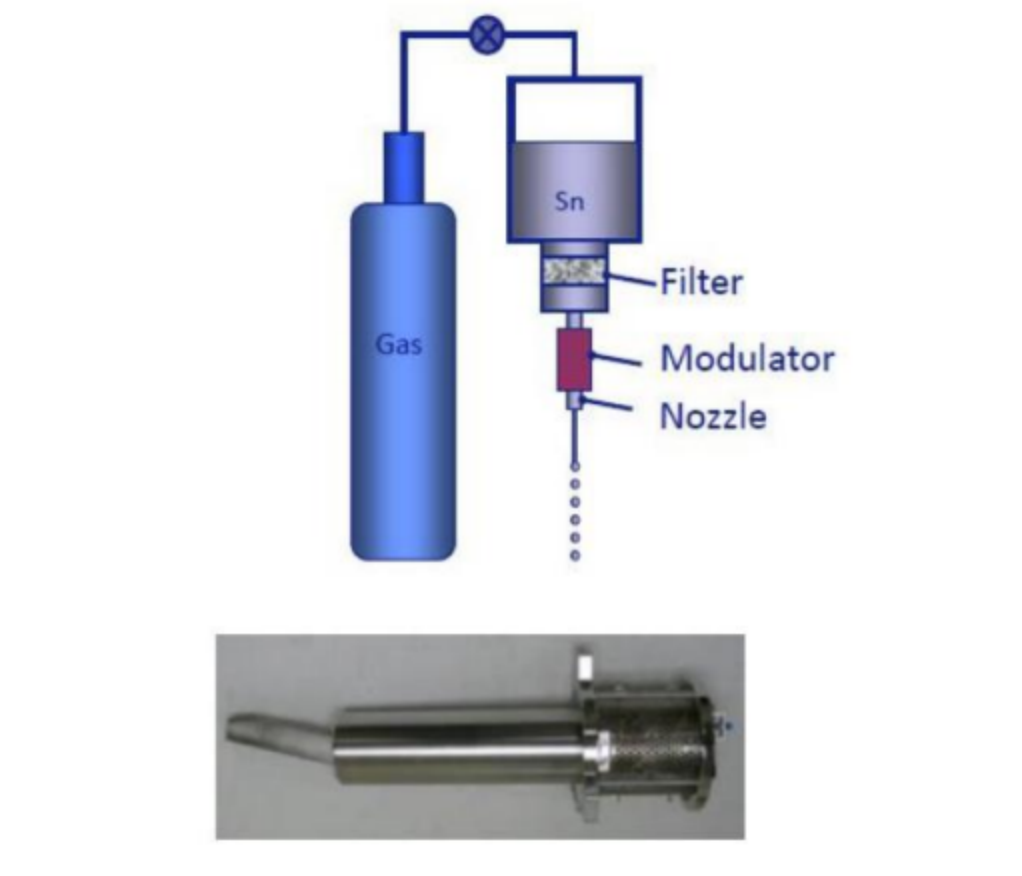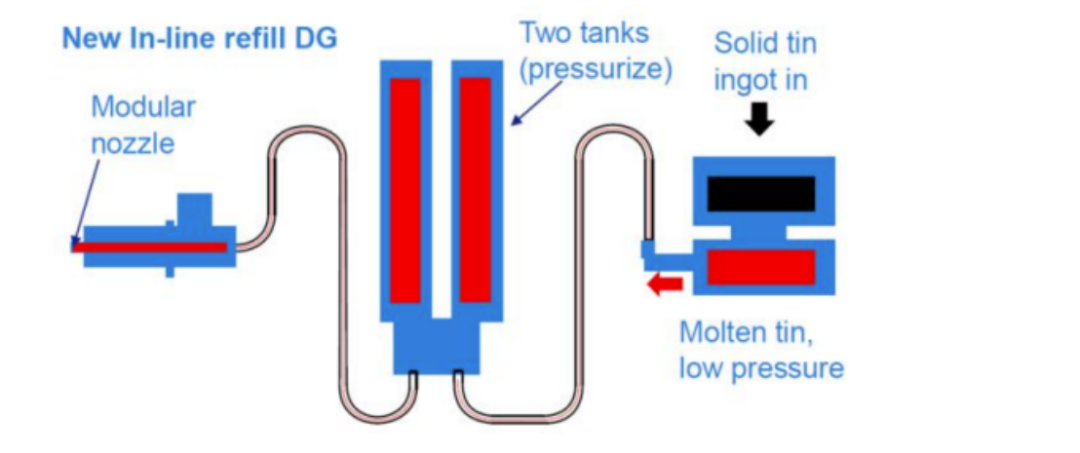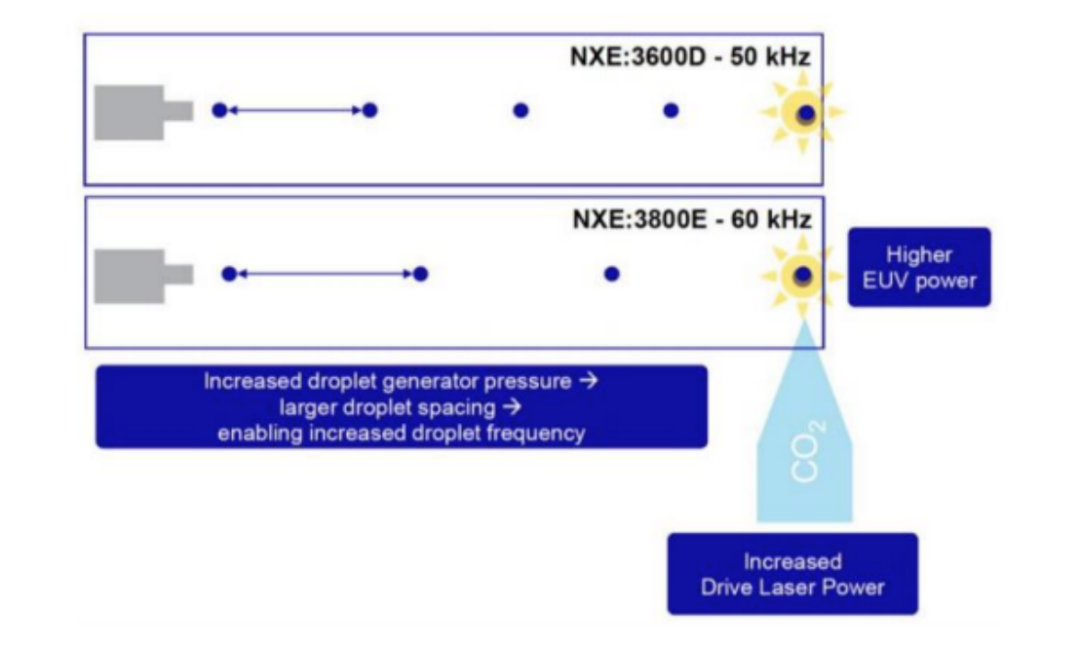Service hotline
+86 0755-83044319
release time:2023-10-14Author source:SlkorBrowse:12663
2.1 Droplet Generator: Extreme Thermophysical Properties and Modeling
The droplet generator is an important component of the EUVL scanner assembly (Figure 3). The droplet generator controls the size, velocity, and repetition rate of the material entering the EUV source chamber, ionized by a carbon dioxide laser, to generate EUV light at 13.5nm. Therefore, reliable droplet generation is essential for EUV light production as any malfunction would result in the shutdown of all downstream components. The typical droplet diameter is 27μm, with a velocity of 80m/s and a repetition frequency of 50kHz. The droplet generator triggers the emission of carbon dioxide laser pulses, earning it the title of the "heartbeat" of the entire EUV scanner assembly.
Tin is the working liquid used in the droplet generator for EUVL applications, as it generates light at a wavelength of 13.5 nanometers when ionized into a plasma state. Over the past decades, researchers have explored the possibilities of materials other than tin, such as xenon gas and lithium. Factors such as safety, cost, and performance have proven tin to be the superior material for laser-produced plasma in EUVL manufacturing applications. In semiconductor manufacturing, there is no common roadmap for materials other than tin, thus investing in the understanding of this material at a fundamental scientific level will have short-term and long-term implications. The industry's focus on a single material, tin, makes it an ideal choice for the complex laser-material interaction required for EUV light generation.
The working principle of the droplet generator involves loading solid high-purity tin (>99.999wt.%) into a container and heating it above its melting point (~232°C). Then, high-purity gas, typically nitrogen, is applied on one side of the liquid inside the container to exert pressure, allowing the molten tin to flow through a filter to the nozzle on the other side. The ejection of tin droplets is usually regulated by piezoelectric (PZT) crystals, generating mechanical vibrations. A photo of a first-generation concept droplet generator is shown in Figure 3, with a droplet position stability of approximately 1μm.

The droplet generator made new advancements in 2021 with its online replenishment capability. Figure 4 shows a reduction in system downtime without interrupting the performance of downstream EUV scanners. With this new droplet generator design, continuous operation for over 3000 hours has been achieved.

To increase productivity and achieve higher EUV power output, it is necessary to increase the driving laser power, resulting in an increased number of droplets per second. To further increase droplet frequency, pressure in the droplet generator needs to be increased. However, this would result in larger droplet spacing. This concept is illustrated in Figure 5.

Currently, under atmospheric pressure, molten metals lack reliable material properties. The lack of this standard data hinders the progress in numerical simulations for creating droplet generators. The practice described by scientists and engineers involves searching for the most recent material properties from published literature and inferring rough estimates. They then rely on empirical observations of the entire system under operating conditions to adjust the relationship between material properties and operating parameters. An industry presenter gave an example illustrating the need for a balanced design in print head to ensure that the working fluid (molten metal) is at a sufficiently high temperature to be in the liquid phase but not too high to melt the piezoelectric element.
The current NIST resource for measuring metal material properties was introduced, with a focus on the NIST alloy database, which is a curated database containing thermophysical properties of metals (including tin). Currently, the entire database is free and open to the public due to funding from the Materials Genome Initiative (MGI) and oversight from the Thermodynamics Research Center (TRC). To continue development, the database can be converted to SRD to maintain it according to the 2017 U.S. Standard Reference Data Act. The ability to provide fair and professionally validated material property data for the U.S. industry can offer efficient design insights and innovations in operating droplet generators. The advantages of SRD in material performance have been recognized internationally, as shown in a publication on SRD in the field of material properties.
One limitation to the effectiveness of NIST's measurement capabilities is the lack of data on molten tin under high pressure applicable to EUVL droplet generators. The characteristics of the working fluid in a droplet generator determine a phenomenon called Rayleigh breakup, which leads to droplet formation and merging. This phenomenon has been extensively researched over the past 40 years, with studies conducted by institutions such as ETH Zurich in 2011 demonstrating the relationship between the diameter and velocity of molten tin droplets at pressures below 4 MPa and frequencies below 100 kHz. A recent article published in 2023 shows the positive pursuit in this research field.
The lack of reference data on molten tin makes it valuable to measure reference quality data to fill databases such as the NIST alloy database with new instrumentations. Speed of Sound (SoS) is a particularly useful material property as it can be combined with density and isobaric heat capacity data at a single (T, p) point to obtain additional thermophysical properties such as density, isobaric expansivity, and isobaric heat capacity at any temperature and pressure. NIST researchers have already demonstrated the measured SoS values for refrigerant materials. Accurate SoS measurements are crucial for achieving the ultimate goal of modeling the thermodynamic properties of materials using equations of state (EoS). The use of different EoSs in simulation accuracy has proven to significantly affect even the simplest geometry.
To be continued...









Site Map | 萨科微 | 金航标 | Slkor | Kinghelm
RU | FR | DE | IT | ES | PT | JA | KO | AR | TR | TH | MS | VI | MG | FA | ZH-TW | HR | BG | SD| GD | SN | SM | PS | LB | KY | KU | HAW | CO | AM | UZ | TG | SU | ST | ML | KK | NY | ZU | YO | TE | TA | SO| PA| NE | MN | MI | LA | LO | KM | KN
| JW | IG | HMN | HA | EO | CEB | BS | BN | UR | HT | KA | EU | AZ | HY | YI |MK | IS | BE | CY | GA | SW | SV | AF | FA | TR | TH | MT | HU | GL | ET | NL | DA | CS | FI | EL | HI | NO | PL | RO | CA | TL | IW | LV | ID | LT | SR | SQ | SL | UK
Copyright ©2015-2025 Shenzhen Slkor Micro Semicon Co., Ltd